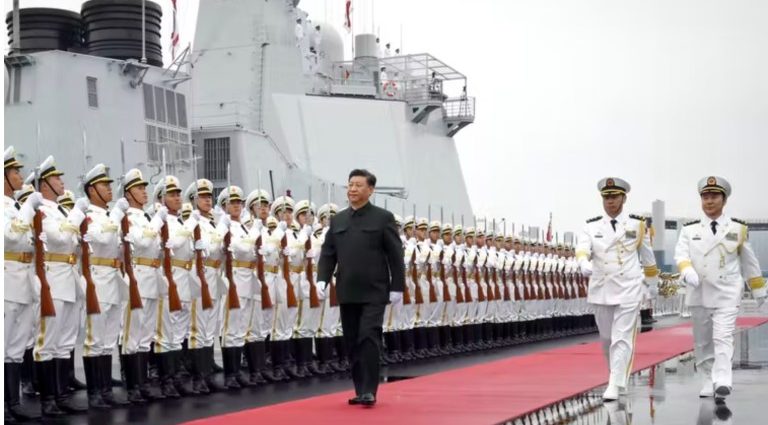The US is seemingly at a loss to match China’s ascendant naval shipbuilding capacity as US Navy leaders engage in a blame game rather than addressing past failures and mismanagement.
CNN reported this month that US Navy Secretary Carlos Del Toro said the US cannot match China in terms of fleet numbers, an admission that could have significant implications for the Pacific region’s power balance.
At the National Press Club in Washington, DC, Del Toro said that China now has a larger fleet and is deploying it globally, making it imperative for the US to upgrade its fleet in response.
According to the Pentagon’s November 2022 China Military Power report, China’s People’s Liberation Army-Navy (PLA-N) is the world’s largest navy with 340 ships as of 2022. The US Navy, in comparison, had just 280 ships.
Del Toro said that China has 13 naval shipyards, with one of these facilities having more capacity than all seven US naval shipyards combined. He also highlighted problems in finding skilled labor for US naval shipbuilding programs.
A December 2022 US Congressional Research Service report states that budget cuts and other issues have resulted in layoffs of shipyard workers whose specialized skills cannot easily and readily be replaced.
In his speech, Del Toro also said China does not face the same restrictions, regulations and economic pressures that hound US shipbuilders while accusing China of using “slave labor” in its naval shipbuilding program, without providing corroborating evidence.

However, defense policy expert Blake Herzinger said that Del Toro’s remarks were typical of the US Navy’s leadership response to China’s ascendant shipbuilding program, which he said tends to criticize China rather than acknowledge US failures, CNN reported.
In a December 2018 Center for Strategic and International Studies (CSIS) report, the Washington-based think tank said the US has focused on expanding naval shipbuilding instead of integrating civilian and military shipbuilding operations.
This philosophy, the report notes, is due to the different requirements of civilian and military shipbuilding, with consolidation potentially affecting the productivity and efficiency of both.
However, in an October 2021 article for Foreign Policy, Alexander Wooley notes that US naval shipbuilding woes can be traced to the post-Cold War “peace dividend,” which resulted in the private shipbuilding industry successfully lobbying the Clinton administration to take over engineering and design work traditionally done by the US Navy.
In the late 1900s, Wooley notes, the US Navy subsequently sought cost savings by reducing in-house naval architecture and engineering staff by 75%, from 1,200 to roughly 300.
Wooley also notes that the lack of new shipbuilding facilities has left US warships staying longer at shipyards for repairs, giving little incentive for shipyards to invest in increasing production capacity and thus resulting in the loss of skilled workers, technical know-how and subcontractors.
In contrast, China has chosen to apply its civil-military fusion strategy to its naval shipbuilding program to boost productivity.
This strategy brings several other advantages including cost savings, shortened development time and production cycles, improved military equipment quality and overall more efficient production, as well as allowing military industries to leverage advances in civilian technology, notes Richard Blitzinger in a January 2021 report for the S Rajaratnam School of International Studies (RSIS) in Singapore.
The approach also builds on China’s centralized and top-down strategic culture, enabling it to quickly shift attention, capital and resources to strategic sectors such as shipbuilding.
According to the 2022 United Nations Conference on Trade and Development Statistics Handbook, China built 44.2% of the world’s merchant fleet last year, followed by South Korea at 32.4% and Japan at 17.6%. In contrast, the data shows that the US built only 0.053% of the world’s total merchant fleet in 2022.

Monty Khanna notes in a 2019 article in the peer-reviewed journal Maritime Affairs: Journal of the National Maritime Foundation of India how China manages to build warships quickly and efficiently.
Khanna notes that China’s concurrent building of warships and civilian ships in the same shipyards has allowed its shipbuilding industry to operate at capacity regardless of economic downturns, apply mass-production techniques for civilian ships to naval shipbuilding, apply advanced civilian technologies into warships, maintain surge production capability for naval shipbuilding and circumvent sanctions targeting its military modernization programs.
Still, China’s shipbuilding program has its share of challenges. For example, in a 2015 article, Andrew Erickson notes that China still relies on foreign sources for surface ship and submarine propulsion.
A June 2021 article from Deutsche Welle reports that engines from German manufacturer Motoren und Turbinen-Union (MTU) are used in China’s Luyang III destroyers and Song-class submarines, with Beijing able to evade EU sanctions due to the engines’ dual-use applications.
Moreover, Erickson also says that China still has difficulty producing sophisticated sensors. Along those lines, in September 2021, a US court sentenced a Chinese national for smuggling US hydrophones that could be used for anti-submarine warfare to the Chinese military.
Erickson also notes that adherence to quality control standards may be a weakness in China’s naval shipbuilding program due to a cultural emphasis on personal relations and pragmatism, which he argues may result in problems in compliance to strict standards compared to Western ship-builders.
He also points out that China’s centralized and top-down strategic culture can result in bureaucratic inefficiencies and ineffectiveness.
Erickson also points out that China’s shipbuilding workforce remains relatively undereducated, resulting in China being capable of building large numbers of large and small non-complex ships.
It’s a deficiency he says China is addressing through partnerships between shipyards and the creation of technical schools to boost the capacity of its shipbuilding workforce.

